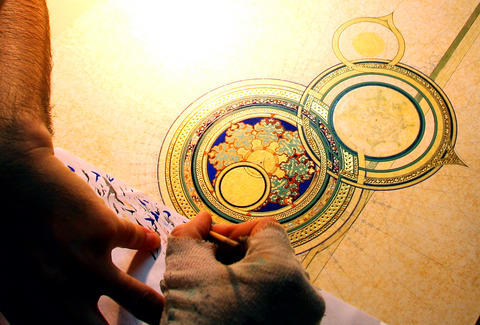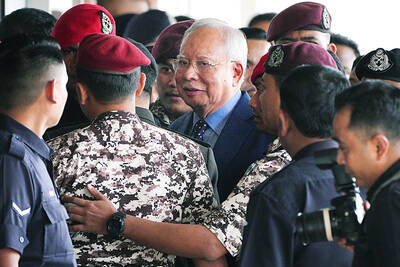Bent over his desk, an Iranian illuminator puts the last touches on a gilded garden of the minuscule intertwined paisleys that have decorated the Koran for hundreds of years.
One of the oldest Iranian art forms, illumination (tazhib) has survived since the pre-Islamic era but now risks extinction if it fails to attract patrons, who prefer modern art to traditional work.
Tazhib is non-figurative illumination whose geometric flourishes, decorations and intricate calligraphy have traditionally adorned the margins of holy books and epic poems, as well as being an art form in its own right.

PHOTO: AFP
"The perfection and harmony of this art speaks for itself," said illuminator Fereidoon Joghan, who has spent the past quarter of a century mastering this most rarefied of arts.
"I would like to create something beautiful rather than screaming a message," said the artist, who has won numerous national awards in Islamic decorative arts.
Joghan tries to work using traditional methods, including brushes made from cat's fur, and remaining as faithful as possible to the motifs and techniques created by masters hundreds of years ago.
Ridiculed by peers in Tehran's prestigious school of fine arts for his passion, Joghan said he had to abandon illumination temporarily at college, where he experimented with modern painting.
"The harmony and the intense concentration calm me to an extent that I forget all my problems," he said.
The art dates back to the Sassanid era in pre-Islamic Iran but flourished after the 7th century advent of Islam, which banned human depictions.
Faced with such limitations, Iranian artists poured their creative talent into beautifying the holy script, carpets and mosques.
"After Islam, the Koran was the only outlet of artistic work and it was the sanctity and importance of the book that has kept illumination alive through the ups and down of history," fellow tazhib artist Mehdi Moghiseh said.
The best works of illumination were created in the 15th century under the Timurid dynasty, when Iran's rulers of Mongol origin were great patrons of Persian art and literature.
This heyday of tazhib was sponsored by rulers who commissioned artists to enhance calligraphy in Koran and complement miniatures in the Shahnameh (Book of Kings), a 10th-century poetic chronicle of Iran's myths and ancient history.
Both artists are pessimistic about the future of tazhib, however, as it is almost impossible to market the work in the modern world.
Joghan spends eight hours a day working for four months on a piece no larger than a medium-sized book which is worth 100 million rials (US$11,000). He has not sold a work in years.
The related, figurative, art of miniature painting stands a better chance of survival, experts say, although at a recent exhibition not a single piece could convince visitors to part with their money.
"If the masters cannot make a living out of their work it will fade away. They have to be protected like an endangered species. This is our heritage, our identity," Moghiseh said.
He believes people's lack of interest partly stems from the absence of traditional art forms in modern surroundings.
Moreover, Iran's younger generation also favors art forms which yield immediate results and allow a more liberated expression.
Visiting Tehran's Reza Abbasi museum, which preserves masterpieces of Iranian miniature, ceramic, calligraphy and illumination, Kamran Hamzeloo is unimpressed by the artistic achievements of his ancestors.
"The works are lovable and subtle, but I think if the Iranian artist of the time had more freedom he would have looked at the world differently," he said.
There are still a few young enthusiasts yearning to fill the shoes of the masters, despite the insecurity and uncertainty they know will come with the job.
"I saw Mr Joghan's works in an exhibition. It touched me in a way that I could not sleep a wink until morning," 28-year-old chemist Maryam Labani said.
"I pestered him on the phone for two weeks to take me on as a student," said Labani, looking through a magnifying glass to put a drop of pink on an octagonal illumination -- work which could be ruined by the slightest false move.

The death of a former head of China’s one-child policy has been met not by tributes, but by castigation of the abandoned policy on social media this week. State media praised Peng Peiyun (彭珮雲), former head of China’s National Family Planning Commission from 1988 to 1998, as “an outstanding leader” in her work related to women and children. The reaction on Chinese social media to Peng’s death in Beijing on Sunday, just shy of her 96th birthday, was less positive. “Those children who were lost, naked, are waiting for you over there” in the afterlife, one person posted on China’s Sina Weibo platform. China’s

‘NO COUNTRY BUMPKIN’: The judge rejected arguments that former prime minister Najib Razak was an unwitting victim, saying Najib took steps to protect his position Imprisoned former Malaysian prime minister Najib Razak was yesterday convicted, following a corruption trial tied to multibillion-dollar looting of the 1Malaysia Development Berhad (1MDB) state investment fund. The nation’s high court found Najib, 72, guilty on four counts of abuse of power and 21 charges of money laundering related to more than US$700 million channeled into his personal bank accounts from the 1MDB fund. Najib denied any wrongdoing, and maintained the funds were a political donation from Saudi Arabia and that he had been misled by rogue financiers led by businessman Low Taek Jho. Low, thought to be the scandal’s mastermind, remains

‘POLITICAL LOYALTY’: The move breaks with decades of precedent among US administrations, which have tended to leave career ambassadors in their posts US President Donald Trump’s administration has ordered dozens of US ambassadors to step down, people familiar with the matter said, a precedent-breaking recall that would leave embassies abroad without US Senate-confirmed leadership. The envoys, career diplomats who were almost all named to their jobs under former US president Joe Biden, were told over the phone in the past few days they needed to depart in the next few weeks, the people said. They would not be fired, but finding new roles would be a challenge given that many are far along in their careers and opportunities for senior diplomats can

Australian Prime Minister Anthony Albanese yesterday announced plans for a national bravery award to recognize civilians and first responders who confronted “the worst of evil” during an anti-Semitic terror attack that left 15 dead and has cast a heavy shadow over the nation’s holiday season. Albanese said he plans to establish a special honors system for those who placed themselves in harm’s way to help during the attack on a beachside Hanukkah celebration, like Ahmed al-Ahmed, a Syrian-Australian Muslim who disarmed one of the assailants before being wounded himself. Sajid Akram, who was killed by police during the Dec. 14 attack, and